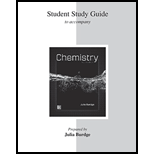
Interpretation:
The hybridization of carbon and nitrogen atoms and the number of sigma bonds and pi bonds in a molecule of tryptophan is to be determined.
Concept Introduction:
Hybridization is the combining of atomic orbitals to form hybrid orbitals.
To determine thehybridization of an atom, first draw the Lewis structure of the molecule.
Find the number of electron domains around an atom to get the number of hybrid orbitals used by the atom for bonding.
When atomic orbitals combine, they form equal number of hybrid orbitals.
The
To find the number of sigma bonds and pi bonds, consider the structure of the molecule and find the number of single and double bonds. In general,
A single bond includesone sigma bond.
A double bond includes one sigma and one pi bond.
A triple bond includes one sigma and two pi bonds.
Want to see the full answer?
Check out a sample textbook solution
Chapter 9 Solutions
Student Study Guide for Chemistry
- Aspirin, or acetylsalicylic acid, has the formula C9H8O4 and the skeleton structure (a) Complete the Lewis structure and give the number of bonds and bonds in aspirin. (b) What is the hybridization about the CO2H carbon atom (colored blue)? (c) What is the hybridization about the carbon atom in the benzene-like ring that is bonded to an oxygen atom (colored red)? Also, what is the hybridization of the oxygen atom bonded to this carbon atom?arrow_forwardCalcium cyanamide, CaNCN, is used both to kill weeds and as a fertilizer. Give the Lewis structure of the NCN2 ion and the bonded-atom lone-pair arrangement and hybridization of the carbon atom.arrow_forwardConsider the polyatomic ion IO65-. How many pairs of electrons are around the central iodine atom? What is its hybridization? Describe the geometry of the ion.arrow_forward
- Do lone pairs about a central atom affect the hybridization of the central atom? If so, how?arrow_forwardIn the molecular orbital mode l, compare and contrast bonds with bonds. What orbitals form the bonds and what orbitals form the bonds? Assume the z-axis is the internuclear axis.arrow_forwardGamma hydroxybutyric acid, GHB, infamous as a date rape drug, is used illicitly because of its effects on the nervous system. The condensed molecular formula for GHB is HO(CH2)3COOH. (a) Write the Lewis structure for GHB. (b) Identify the hybridization of the carbon atom in the CH2 groups and of the terminal carbon. (c) Is hydrogen bonding possible in GHB? If so, write Lewis structures to illustrate the hydrogen bonding. (d) Which carbon atoms are involved in sigma bonds? In pi bonds? (e) Which oxygen atom is involved in sigma bonds? In pi bonds?arrow_forward
- Methylcyanoacrylate is the active ingredient in super glues. Its Lewis structure is (a) How many sigma bonds are in the molecule? (b) How many pi bonds are in the molecule? (c) What is the hybridization of the carbon atom bonded to nitrogen? (d) What is the hybridization of the carbon atom bonded to oxygen? (e) What is the hybridization of the double-bonded oxygen?arrow_forwardIn propene CH3CH=CH2, the first carbon has sp3 hybrid orbitals and the second carbon has sp2 hybrid orbitals. These orbitals interact to make a bond. Why are these hybrid orbitals not orthogonal?arrow_forwardPiperine, the active ingredient in black pepper, has this Lewis structure. (a) Give the values for the indicated bond angles. (b) What is the hybridization of the nitrogen? (c) What is the hybridization of the oxygens?arrow_forward
- Considering only the molecular orbitals formed by combinations of the 2s atomic orbitals, how many molecular orbitals can be formed by 1000 Li atoms? In the lowest energy state, how many of these orbitals will be populated by pairs of electrons and how many will be empty?arrow_forwardThe compound sketched below is acetylsalicylic acid, commonly known as aspirin. (a) What are the approximate values of the angles marked A, B, C, and D? (b) What hybrid orbitals are used by carbon atoms 1, 2, and 3ss?arrow_forward
 Chemistry: The Molecular ScienceChemistryISBN:9781285199047Author:John W. Moore, Conrad L. StanitskiPublisher:Cengage Learning
Chemistry: The Molecular ScienceChemistryISBN:9781285199047Author:John W. Moore, Conrad L. StanitskiPublisher:Cengage Learning ChemistryChemistryISBN:9781305957404Author:Steven S. Zumdahl, Susan A. Zumdahl, Donald J. DeCostePublisher:Cengage Learning
ChemistryChemistryISBN:9781305957404Author:Steven S. Zumdahl, Susan A. Zumdahl, Donald J. DeCostePublisher:Cengage Learning Chemistry & Chemical ReactivityChemistryISBN:9781337399074Author:John C. Kotz, Paul M. Treichel, John Townsend, David TreichelPublisher:Cengage Learning
Chemistry & Chemical ReactivityChemistryISBN:9781337399074Author:John C. Kotz, Paul M. Treichel, John Townsend, David TreichelPublisher:Cengage Learning Chemistry & Chemical ReactivityChemistryISBN:9781133949640Author:John C. Kotz, Paul M. Treichel, John Townsend, David TreichelPublisher:Cengage Learning
Chemistry & Chemical ReactivityChemistryISBN:9781133949640Author:John C. Kotz, Paul M. Treichel, John Townsend, David TreichelPublisher:Cengage Learning Chemistry: Principles and PracticeChemistryISBN:9780534420123Author:Daniel L. Reger, Scott R. Goode, David W. Ball, Edward MercerPublisher:Cengage Learning
Chemistry: Principles and PracticeChemistryISBN:9780534420123Author:Daniel L. Reger, Scott R. Goode, David W. Ball, Edward MercerPublisher:Cengage Learning Chemistry: Principles and ReactionsChemistryISBN:9781305079373Author:William L. Masterton, Cecile N. HurleyPublisher:Cengage Learning
Chemistry: Principles and ReactionsChemistryISBN:9781305079373Author:William L. Masterton, Cecile N. HurleyPublisher:Cengage Learning





